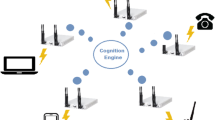Abstract
Single frequency network (SFN) can provide Multimedia Broadcast Multicast Service (MBMS) over a large coverage area, so it receives more and more attention from both academia and industry. However, the application of SFN is still restricted by a large number of feedbacks. Therefore, we propose a novel multicast resource allocation algorithm based on limited feedback scheme. In the algorithm, we first design a user limited feedback scheme based on channel gain threshold to effectively reduce feedback load. The scheme determines to which base stations users should report channel state information. Next, to overcome the MBMS capacity limitation drawback, we encode the MBMS data into a base layer and multiple enhancement layers and develop a joint subcarrier and power allocation strategy to maximize the throughput of enhancement layers while guaranteeing the rate requirement of base layer. Simulation results show that the proposed algorithm significantly reduces 83 % of the feedback overhead while achieving a comparable multicast throughput performance to the case of full feedback.








Similar content being viewed by others
References
Vella, J., & Zammit, S. (2013). A survey of multicasting over wireless access networks. IEEE Communications Surveys & Tutorals, 15(2), 718–753.
Mingming, L., Xiaoxiang, W., Jia, Z., & Jing, Q. (2014). Adaptive user selection of opportunistic multicast scheduling in wireless networks. IET Communications, 8(6), 964–971.
Ko, C., Chou, C., Meng, H., & Wei, H. (2015). Strategy-proof resource allocation mechanism for multi-flow wireless multicast. IEEE Transactions on Wireless Communications, 14(6), 3143–3156.
Tan, C. K., Chuah, T. C., & Tan, S. W. (2011). Adaptive multicast scheme for OFDMA based multicast wireless systems. IEEE Electronics Letters, 47(9), 570–572.
Tian, L., Zhou, Y., Zhang, Y., Sun, G., & Shi, J. (2012). Resource allocation for multicast services in distributed antenna systems with quality of services guarantees. IET Communications, 6(3), 264–271.
Tan, C. K., Chuah, T. C., Tan, S. W., & Sim, M. L. (2012). Efficient clustering scheme for OFDMA-based multicast wireless system using grouping genetic algorithm. IEEE Electronics Letters, 48(3), 184–186.
Xiaolu, W., Yueyun, C., Xiaopan, Y., & Mkiramweni, M. E. (2014). Joint resource allocation and power control for cellular and device-to-device multicast based on cognitive radio. IET Communications, 8(16), 2805–2813.
Militano, L., Condoluci, M., Araniti, G., Molinaro, A., Lera, A., & Muntean, G. (2015). Single frequency-based device-to-device-enhanced video delivery for evolved multimedia broadcast and multicast services. IEEE Transactions on Broadcasting, 61(2), 263–278.
Kim, S., & Lee, S. (2015). Coordinated multicast based on MIMO relay station in a single frequency network. IEEE Transactions on Vehicular Technology, 6(99), 1–12.
Lanza, M., Gutierrez, A. L., & Perez, J. R. (2014). Coverage optimization and power reduction in SFN using simulated annealing. IET Communications, 60(3), 474–485.
Wenrong, G., Xiaoxiang, W., Mingming, L., & Zijia, H. (2014). Round-robin resource sharing algorithm for device-to-device multicast communications underlying single frequency networks. In: Proceedings of the International Conference on IEEE International Conference on Telecommunications (ICT), May 2014 (pp. 191–195). Nanjing, China.
Dong-Hoi, K. (2014). Adaptive handover scheme for evolved multimedia broadcast multicast services in long term evolution networks. IET Communications, 8(16), 2933–2942.
Tassi, A., Khirallah, C., Vukobratoic, D., Chiti, F., Thompson, J. S., & Fantacci, R. (2015). Resource allocation strategies for network-coded video broadcasting services over LTE-Advanced. IEEE Transactions on Vehicular Technology, 64(5), 718–753.
Ya-Ju, Y., Pi-Cheng, H., & Ai-Chun, P. (2012). Energy-efficient video multicast in 4G wireless systems. IEEE Transactions on Mobile Computing, 11(10), 1508–1522.
Kwon, H., & Byeong, G. L. (2009). Cooperative power allocation for broadcast/multicast services in cellular OFDM systems. IEEE Transactions on Communications, 57(10), 3092–3102.
Lei, C., Xiaoxiang, W., & Gaoning, H. (2013). Dynamic resource allocation with precoding and joint coding scheme for limited feedback-based wireless multi-antenna multicast system. IET Communications, 7(5), 397–407.
Anastasopoulos, M., Tabeb, T., Cottis, P., & Obaidat, M. (2012). Feedback suppression in multicast satellite networks using game theory. IEEE Systems Journal, 6(4), 657–666.
Acknowledgments
This work was supported by the Higher Education Research Foundation of Doctoral Program (20120041110011), and the National Nature Science Foundation of China (6117258).
Author information
Authors and Affiliations
Corresponding author
Rights and permissions
About this article
Cite this article
Chen, L. Layered Multicast Resource Allocation with Limited Feedback Scheme in Single Frequency Networks. Wireless Pers Commun 87, 1131–1146 (2016). https://doi.org/10.1007/s11277-015-3044-4
Published:
Issue Date:
DOI: https://doi.org/10.1007/s11277-015-3044-4




